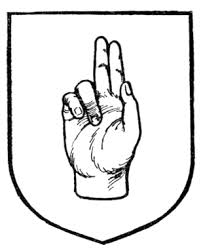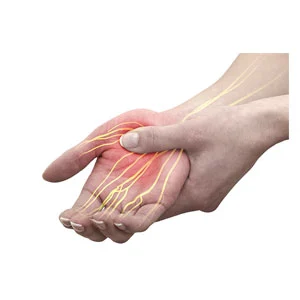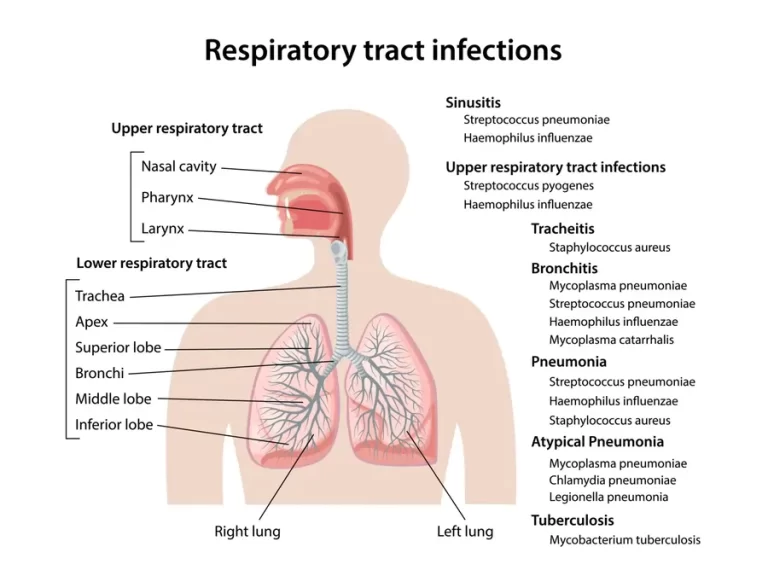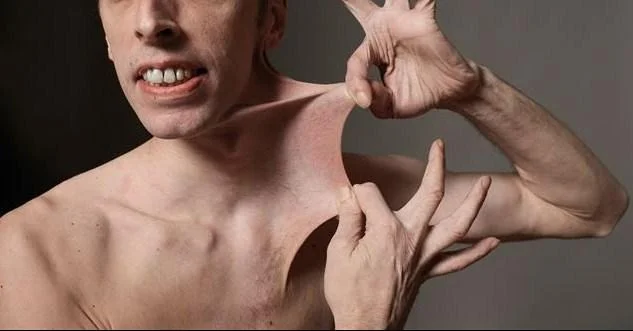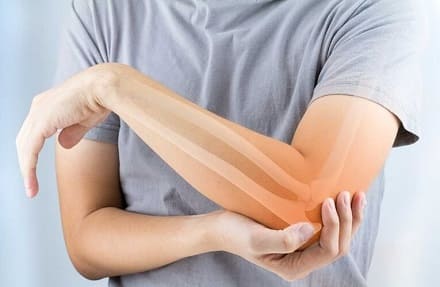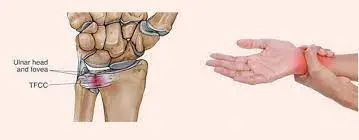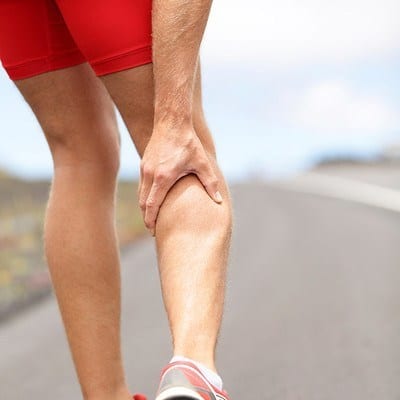Hand of Benediction Sign:
Table of Contents
Overview:
Hand of Benediction sign is a clinical significant by ulnar neuropathy of the hand. It results in the functional limitation of the intrinsic muscles of the hand that act on the metacarpophalangeal and interphalangeal joints. The intrinsic muscles may be affected the interossei and lumbrical muscles. It is also called AKA preacher’s hand.
The interossei muscles function adduct and abduct the second, third, and fourth fingers, whereas the lumbricals help to flex the metacarpophalangeal joints and extend the proximal and distal interphalangeal joints.
As a result of ulnar nerve injury, these intrinsic muscles will loss their function, producing the Benediction sign. This sign is known as the Preacher’s hand and “main-en-griffe.”
It is seen when the ask to the patient to make a fist and the ring and little finger flex but the index and middle finger can not flex at the metacarpal-phalangeal joint or interphalangeal joint. Sensations are also lost on that affected fingers. pain is present in the hand or fingers. It is usually occurs as a result of prolonged compression or injury to the median nerve at the forearm or elbow.
What is benediction sign?
Hand of benediction is a clinical sign, it happen peripheral nerve damage to outside the brain and spinal cord, specifically affecting the muscles of the hand which is supplied by that nerve. The Benediction Sign occur if the median nerve or the ulnar nerve is damaged.
It is seen when a person is asked to make a fist or open their hand, resulting in the index and middle finger are extended and another fingers do the work in normal like bent or extend movement. This known the hand gesture of the pope giving their blessing (a papal benediction), leading to the name hand of benediction.
The Benediction Sign is seen as a median nerve injury because that give result in an inability to perform flexion at the MCP and IP joints of the 2nd and 3rd digits.
What are the causes of benediction sign?
Hand of benediction is caused by damage to the ulnar or median nerve, resulting in dysfunction of the muscles of the hand.
The ulnar nerve travels from the brachial plexus runs down behind the elbow, and go to the front of the forearm and hand. It supplies the muscles of the 4th and 5th digits. The ulnar nerve damaged due to many different reasons, like if there is fracture or injury to the medial epicondyle of the humerus, nerve compression due to any injury, any type of wrist injury.
The muscles are the interossei, hypothenar, and two of the lumbrical muscles of the hand which is supplied by the ulnar nerve. They are involved in spreading the fingers outside and bringing it together, and the flexion movement of fingers. If the ulnar nerve damage, the ring finger and little finger are not able to abduct from the middle finger and they can not be able to flex at the metacarpophalangeal (MCP) joints. The proximal interphalangeal joints (PIP) and the distal interphalangeal joints (DIP) joints remain in flex position. This results in the hand of benediction the individual tries to open their hand and extend the fingers.
Median nerve injury can also given this deformity. The median nerve originates from the brachial plexus and runs down the forearm and given to motor function of flexion movement of the index and middle finger. Most Common causes of median nerve injury include direct trauma to the wrist or elbow, fracture of the humerus bone, carpal tunnel syndrome (compression of the median nerve at the wrist). Only the last two fingers are able to flex, while the index and middle fingers are extended. This presentation of the hand of benediction occurs when the individual to make a fist, and the thumb and first two fingers remaining partially extended.
What are the sign and symptoms of the benediction?
In the hand of benediction, the patient may feel numbness in the fingers, as well as weakness of the hand muscles.
If the hand of benediction is caused by the ulnar nerve injury the person may have loss of wrist flexion, loss of flexion of the ring finger and little finger, loss of sensation in the half area of palm,half of ring finger and little finger and also an unable to extension of the PIP and DIP joint or unable to do abduction and adduction movement of the last two fingers.
By the median nerve injury, loss of movements—like affect the movement of the thumb to touch the fingers tip, the wrist flexion, flexion movement of the 2nd and 3rd fingers and extension at the PIP and DIP joints of fingers. Also due to the median nerve injury loss of sensation in the base of the thumb, 2nd and 3rd finger and half of ring finger. Numbness is also present in that area of the hand which is supplied by the median nerve.
So that depending on the particular nerve injury, individuals may feels the tenderness or pain at the wrist or elbow area.
Clinically Relevant Anatomy:
Ulnar Nerve Injury:
The ulnar nerve originate from C8 , T1 sometimes C7 branch of the medial cord of the brachial plexus. The ulnar nerve travels down in the arm at the medial side of the brachial artery. It passes behind the medial epicondyle of the humerus and then enters into the forearm between the two heads of flexor carpi ulnaris muscle. Then it goes into the palm through the Guyon’s canal and supply the medial half of the hand.
Muscles of the forearm which is supplied by the ulnar nerve:
- Flexor carpi ulnaris muscle
- Medial half of Flexor digitorum profundus muscle.
Muscles of the hand which is supplied by the ulnar nerve:
- Hypothenar muscle
- Medial two lumbricals
- Adductor pollicis
- Palmar and dorsal interossei of the hand
- Palmaris Brevis
Median Nerve Injury:
It originates from the C5 to T1 of the lateral and medial cord of the brachial plexus. From the axilla it runs down the arm with lateral to the brachial artery then the medial side of the arm in the medial bicipital groove nerve enters the forearm through the two heads of the pronator teres muscle. Also it travels through the anterior forearm between the flexor digitorum superficialis muscles and flexor digitorum profundus muscles and gives the difrerent motor branches. Then it go in to the hand through the carpal tunnel. Gives the motor and sensory branch in to the hand.
Three Branches main branches in the forearm:
- Anterior interossious nerve
- Deep branch
- Superficial/ Palmar cutaneous branch
Forearm Muscles which is supplied by the Median nerve:
- Pronator teres and pronator quadratus muscle
- Flexor carpi radialis muscle
- Palmaris longus muscle
- Flexor digitorum superficialis muscle
- Flexor digitorum profundus muscle
- Flexor pollicis longus muscle
The median nerve also supplies the Muscles of the hand :
- Lateral two lumbricals
- Opponens pollicis
- Abductor pollicis brevis
- Flexor pollicis brevis
Clinical Presentation of Hand of Benediction Sign:
If the patient has Benediction Hand, feels the numbness in the fourth and fifth fingers and weakness of hand muscles. The ring finger and little fingers shows a clawed-like, with hyperextension at the metacarpophalangeal (MCP) joints and flexion of the proximal and distal interphalangeal (IP) joints, and the other two fingers and thumb are in abducted position. Tenderness or pain may be present at the medial wrist or medial side of elbow region.
Diagnosis of the Benediction sign of the hand:
Physical Findings:
When the person have any ulnar or median nerve injury and they have this type of signs and symptoms so that person go to the doctor and doctor asked them to whole history about the injury. Diagnosis is confirmed after the physical and radiological examination.
If the ulnar nerve injury is happen so that special test of that are following:
Froment sign: It is seen due to the weakness of the adductor pollicis muscle, which work on the adduction movement the thumb. When the clinician tell the patient to pinch a piece of paper between the thumb and index fingers and patient cant do it.
Wartenberg sign: In this the weakness of the third palmar interosseous muscle are present. So that inability to adduct the little finger.
If the median nerve injury is happen so that special test of that are following:
- Tinnels sign: In this dr compress the median nerve at wrist by the any instrument or the own thumb and if the tingling and shock like sensation is present in the hand so that the test is positive.
- Doctor check the forearm and hand movement that patient do properly or not.
- Check the sensation in the hand, check the reflexes for that particular nerve.
After the physical findings the the radiological investigation are also useful to confirm the diagnosis.
Radiological investigations:
- Electromyography (EMG) test.
- Nerve conduction studies (NCV TEST).
- Ultrasound studies.
By this studies to check the which nerve is affected and check electrical activity of the nerve. Injured nerve has slow conductivity or electrical activity to that innervated muscles.
Treatment of the Hand of Benediction sign:
Treatment for hand of benediction including the managing and treating the peripheral neuropathy of the median or ulnar nerve.
Medical treatment:
- Non-steroidal anti-inflammatory drugs (NSAIDs): It is used to prevent the worsening of condition and help to decrease the pain. Use the aspirin or ibuprofen drugs.
- Splint: It may be prescribed to prevent the further deformity or prevent the excessive movement of the hand and fingers.
Surgical Treatment:
In some cases the surgical treatment is required to relive the pressure on the nerve. Nerve grafting , Nerve repair etc surgery are required to correct the deformity.
The hand of benediction sign is occur by carpal tunnel syndrome affecting the median nerve in which nerve decompression surgery may be performed. In the surgery cutting the tissue surrounding the nerves to reduce pressure,relieving pain and numbness.
Physiotherapy treatment of Hand of Benediction Sign:
Hand exercise’s aims to improve the mobility and strength of the hand and improving functional ability. Hand exercise are including:
- Joint Mobilising exercise:
- Progression in manual therapy:
- Active movement exercise:
- Strengthening exercise:
- Stretching exercise:
- Hand Braces use:
- Electrical Stimulation:
- Gripping exercise:
- Compression exercise:
- Soft tissue massage:
- Nerve gliding exercise:
- Patient’s education:
Electrical stimulation:
Electrical stimulation is used to given a recovery progression of nerve.
When Patient comes with the nerve injury first therapist check RD Test. According to the result of this test therapist decide to which type of current is applied on injured nerve. If the RD-test is Positive, first given the Galvanic Current to the injured nerve after that in progression given the SF Current(surge faradic current).
Faradic current is useful for muscle strengthening.
Joint Mobilising Exercise:
Mobilising technique is used to increase or maintain range of motion of the hand and fingers.
In the benediction sign the 2nd and 3rd phalanges are in extended position cant be flexed so given the mobilization to the MCP, PIP and DIP joints to improve the flexion movement and 4th and 5th phalanges are in flexed position not to be extended so that given the mobilization to MCP, PIP and DIP joints to improve the extension movement.
Given the mobilisation to the thumb also to improve that all movements of the thumb. Also given the mobilization technique to the wrist.
Soft tissue massage:
In this condition the ulnar or median nerve are involved so that innervates muscles are affected. Therefore given the gentle massage to the forearm, hand muscles to decrease pain and inflation.
Manual therapy:
First to check the grading of muscles and check the wrist and fingers movement, patient actively do or not.
If the patient cant do the movement actively or muscle grade is zero so that therapist give the passive movement of the affected then gradually in progression go for the active assisted movement if muscle grade is 1 to 3 and if the muscle grade 3 to 5 given active movement.
Once the patient do the movement actively then do movement of hand with weight cuff.
Stretching Exercise:
If the forearm and hand muscles are tight so that given the stretching to that muscle for release the tissue.
Stretching is given after achieving the active movement of the muscles. Given flexor and extensor muscles stretching to the forearm and hand or fingers.
It is given to 3 rep. and 30 sec hold in each rep.
Compression exercise:
In this the all fingers are open and put the pressure on the hand and fingers and hold it for 3 to 4 mins so that the fingers are become straight. Repeat it 3 time in day.
Gripping Exercise:
This exercise done with the soft rubber ball.
Therapist give to the patient soft rubber ball ask him to hold it in affected palm and press it for 20 to 30 sec and then release repeat it 5 to 10 times and also do this at home in whole day. After that in progression this exercise done with the hand spring bar to improve the strength of hand muscles.
Use of Hand Braces:
Patient use hand splint to the hand support and prevent the excessive movement of hand and fingers.
Strengthening Exercise:
This is done with the therapeutic rubber band or use of weight cuff or dumbbells.
Once the patient achieve the normal active movement of the affected hand then do the all movement with the therapeutic band or dumbell to strengthen the hand and fingers muscles. it is repeat with the 5 to 10 times according to the patient strength.
Nerve gliding Exercise:
Glide for median nerve:
First rotate the body away from the arm and when you feel a gentle stretch then down the arm. Flex your neck to the opposite shoulder and loosen the tension off your hand simultaneously and do glide of the nerve. 10 to 15 glide the back to starting position and continue to alternate between these two positions.
Glide for ulnar nerve:
Patient Put the hand over an ear, with the elbow facing forward then gently pull your elbow back towards the wall till patient feel stretch you reached the end point for better stretch, Bring the elbow forward and relax. Then repeat it.
Prevention of benediction sign:
Occupation therapy and wearing splints may help to prevent of recurrence of median nerve injury so that the deformity is also prevent. Although it is not possible to totally stop trauma to arm and wrist, patients may prevent excessive movement by the use of splint and it gives a support to the hand.. Also, strengthening and increase flexibility will decrease the risk of nerve compression.

